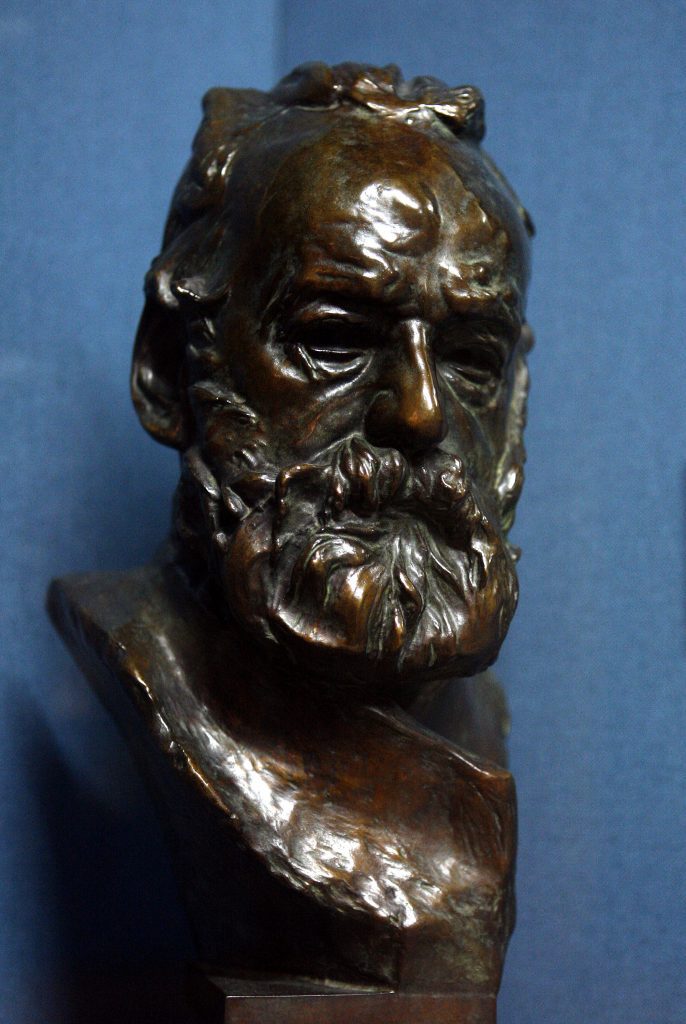
Auguste Rodin, born François-Auguste-René Rodin on November 12, 1840, in Paris, France, is widely acknowledged as a progenitor of modern sculpture. His work departed from the prevailing decorative, formulaic, and highly thematic approaches of his time, introducing forms that emphasized the complexity and vitality of the human body and spirit. Rodin’s sculptures are celebrated for their realism, expression of character and emotion, and innovative use of texture and form. This biography explores the life, career, and legacy of Auguste Rodin, whose contributions to art marked a pivotal transition from traditional to modern perspectives in sculpture.
Rodin’s early life was modest and unremarkable. The son of Marie Cheffer and Jean-Baptiste Rodin, a clerk in the Paris police department, Rodin struggled academically, but showed a keen interest in drawing and sculpting from a young age. His first formal art education came at the age of 14 when he enrolled in the Petite École, a school specializing in art and mathematics, where he learned drawing and painting. Despite his talent, Rodin failed three times to gain admission to the prestigious École des Beaux-Arts, a setback that led him to pursue practical craft and decorative work for nearly two decades.

During these early years, Rodin worked in the studios of various established sculptors, including Albert-Ernest Carrier-Belleuse, which took him to Brussels and then back to Paris. This period was crucial for developing his skills in traditional sculpture techniques and for his exposure to the art and architecture of Italy, particularly the works of Michelangelo, which profoundly influenced his style.
Success & Controversy
In the 1870s, Rodin began to gain recognition. His sculpture “The Age of Bronze” (1877), a life-sized male figure that demonstrated an extraordinary realism, caused a scandal. Critics accused Rodin of having cast the work from a living model due to its lifelike detail, an allegation that Rodin vehemently denied. Though the controversy initially brought him notoriety, it eventually helped to establish his reputation as a sculptor capable of imbuing bronze and marble with breath and emotion like few before him.
Rodin’s most famous work, “The Gates of Hell,” was commissioned in 1880 for a new decorative arts museum in Paris. Though the museum was never built, Rodin worked on this monumental project for over 20 years, creating many sculptures that would stand alone as masterpieces, including “The Thinker” and “The Kiss.” Both pieces exemplify Rodin’s innovative approach to form and texture, as well as his ability to convey intense emotional and intellectual depth.

Rodin’s relationship with Camille Claudel, a talented young sculptor who became his assistant and lover, was both passionate and tumultuous. Claudel played a significant role in Rodin’s development as an artist, and their collaboration is marked by a period of great creativity. However, their relationship ended bitterly, with Claudel’s later life overshadowed by tragedy, partially attributed to her turbulent relationship with Rodin.
Despite the controversies and personal challenges, Rodin’s career flourished in the late 19th and early 20th centuries. His works were featured in numerous exhibitions around the world, and he became the first living artist to be honored with a retrospective exhibition at the Musée du Luxembourg in Paris in 1900. Rodin’s approach to sculpture, often focusing on partial figures and fragments, challenged traditional notions of form and composition, influencing countless artists who followed.
Musée Rodin Created
In his later years, Rodin became a prominent public figure, receiving honors and commissions from across Europe and the United States. He donated his own collection of sculptures and art works to the French state on the condition that they turn his residence, the Hôtel Biron in Paris, into a museum dedicated to his works. The Musée Rodin opened in 1919, two years after his death on November 17, 1917, in Meudon, a suburb of Paris.
Rodin’s legacy is profound. His rejection of academic norms and his exploration of the human condition through sculpture opened new avenues for artistic expression in the 20th century. His emphasis on the emotional and psychological, as well as the physical, aspects of the human form, has left an indelible mark on the development of modern sculpture.
Rodin’s work is characterized by its dynamic movement, textural depth, and emotional intensity. He broke away from the idealism of his predecessors, focusing instead on the human body in its most raw and real form. This shift not only revolutionized sculpture but also challenged viewers’ perceptions of art and beauty. Rodin’s influence extended beyond sculpture to impact various art movements, including Expressionism and Surrealism.

Throughout his life, Rodin faced criticism and controversy, yet his dedication to capturing the essence of human experience never wavered. Today, his sculptures are held in museums around the world, revered for their innovative approach and profound emotional depth. Rodin’s legacy is not just in the sculptures he left behind but in his enduring influence on generations of artists who continue to draw inspiration from his work. His life and art exemplify the transition from the traditional to the modern, making Auguste Rodin a central figure in the history of art.




